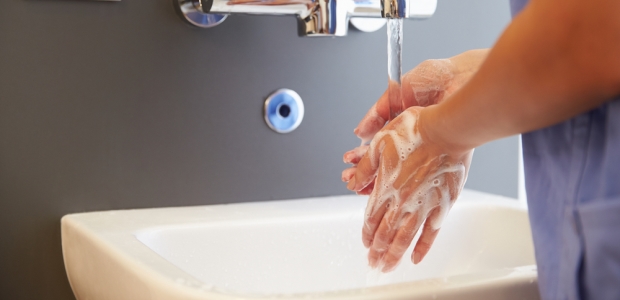
Hand Hygiene When Being Potentially Exposed to Heavy Metal Dust
It is important to recognize that hand washing cannot replace safe and hygienic work practices and the use of personal protective equipment when handling heavy metal-containing materials.
- By Andreas Klotz
- Aug 01, 2016
Heavy metals are natural chemical elements that can be found in rocks of the Earth's crust. Heavy metals have a long history of industrial and personal use. Although they are of natural origin, they are not harmless to human health and can cause both acute and chronic health issues. Heavy metals tend to accumulate in the body, increasing in concentration over time and becoming more toxic. A worsening medical condition due to heavy metal dust exposure is often misdiagnosed at first because exposure happens over an extended period of time.
Heavy metals can enter the body through inhalation of dust, ingestion and sometimes skin penetration. Workers exposed to heavy metals on the job may potentially bring it home on clothing and shoes, exposing family members. Typical symptoms of overexposure to heavy medal dust are weakness, anemia, damage to the neural system, as well as kidney and brain damage. At very high levels, heavy metal poisoning will be fatal.
The three most relevant heavy metals in occupational and private settings are mercury, cadmium, and lead. Some soils are contaminated with heavy metals from smelters or junkyards handling recycling metals.
Mercury
Sources of mercury exposure include mining, production, and handling, as well as mining and refining of gold and silver ores. Mercury can be found in numerous consumer products, such as fluorescent light bulbs, electrical devices, and dental amalgam fillings. Old-style thermometers used to contain mercury; however, these are increasingly being phased out in favor of non-mercury digital thermometers.
Cadmium
Cadmium is an extremely toxic metal. Besides the effects listed above, it is also a carcinogen and linked to causing pancreatic cancer. Due to its high toxicity, the use of cadmium has considerably decreased. Cadmium can be found in rechargeable batteries (NiCd), in soldering preparations, as a corrosion inhibitor, in some electronic products, and in certain dye pigments. Cadmium is also present in industrial workplaces where any ore is being processed or smelted.
Lead
Occupational exposure to lead is one of the most prevalent overexposures. Industries with potentially high exposures include smelter operations, battery manufacturing and maintenance, and firing ranges. Gasoline and paint are now lead-free in North America and many other countries.
Despite the 1978 ban, lead paint on the walls of older homes and buildings continues to be a primary source of lead exposure for children. In certain areas and homes, lead from paint contaminates soil and house dust. Drinking water also can contain lead that leaches out of old lead pipes and lead-containing solder.
How to Protect Yourself
Good hygiene practices play an important role in the protection from heavy metals. To avoid ingestion of lead contamination, proper hand hygiene should be practiced. Eating, drinking, smoking, sneezing, or touching the face with unwashed and contaminated hands can put the individual at high risk. It is also important to wear personal protective equipment. This includes gloves, respirators (where appropriate), and work wear that is regularly washed and not worn outside of work.
It is important to implement a comprehensive skin care regimen. Applying a pre-work product before starting work helps make the removal of metal dust from hands easier and aids to protect the skin from work-related irritants and metal dust.
Proper hand cleaning, as part of a skin care program, is an essential measure to remove heavy metal contamination from hands.
Do not use any industrial solvents or industrial cleaning agents to clean your skin. Avoid using a brush or pumice stone when washing your skin. Cleaning your skin with cold to tepid water is best; the higher the water temperature, the more the skin suffers. Make sure ingredients are kind to the skin: ideally use solvent-free hand cleansers; do not use washing pastes containing pumice.
Qualitative tests conducted by Deb® R&D demonstrated that the use of Kresto® Classic, a hand cleanser paste with natural scrubbers for extra-heavy duty contamination, will help remove lead from the hands. The use of commercially available special lead removing cleansers showed no qualitative benefit over the use of the cleanser. However, it is important to recognize that hand washing cannot replace safe and hygienic work practices and the use of personal protective equipment when handling heavy metal-containing materials.
Although the use of textile cleaning wipes is convenient, there is always the risk of re-contamination from the wipe. Additionally, skin areas not wiped thoroughly may still have lead contamination. Therefore, cleaning with a hand cleanser and water is the preferred method.
Ensure that you thoroughly wash the whole hand, including fingernails and the forearm, as well. Additionally, don't forget to wash the face with an approved liquid soap. Avoid splashing with water to avoid contaminating the area around sinks with heavy metals. Wash the hands for at least 30 seconds and dry with disposable paper towels.
Finally, apply an after-work cream to help the skin restore its natural barrier function and keep hands conditioned.
Sometimes the most dangerous contaminants to workers are the invisible ones. The proper introduction of a comprehensive skin care regimen can go a long way to keeping workers healthy for years to come.
This article originally appeared in the August 2016 issue of Occupational Health & Safety.